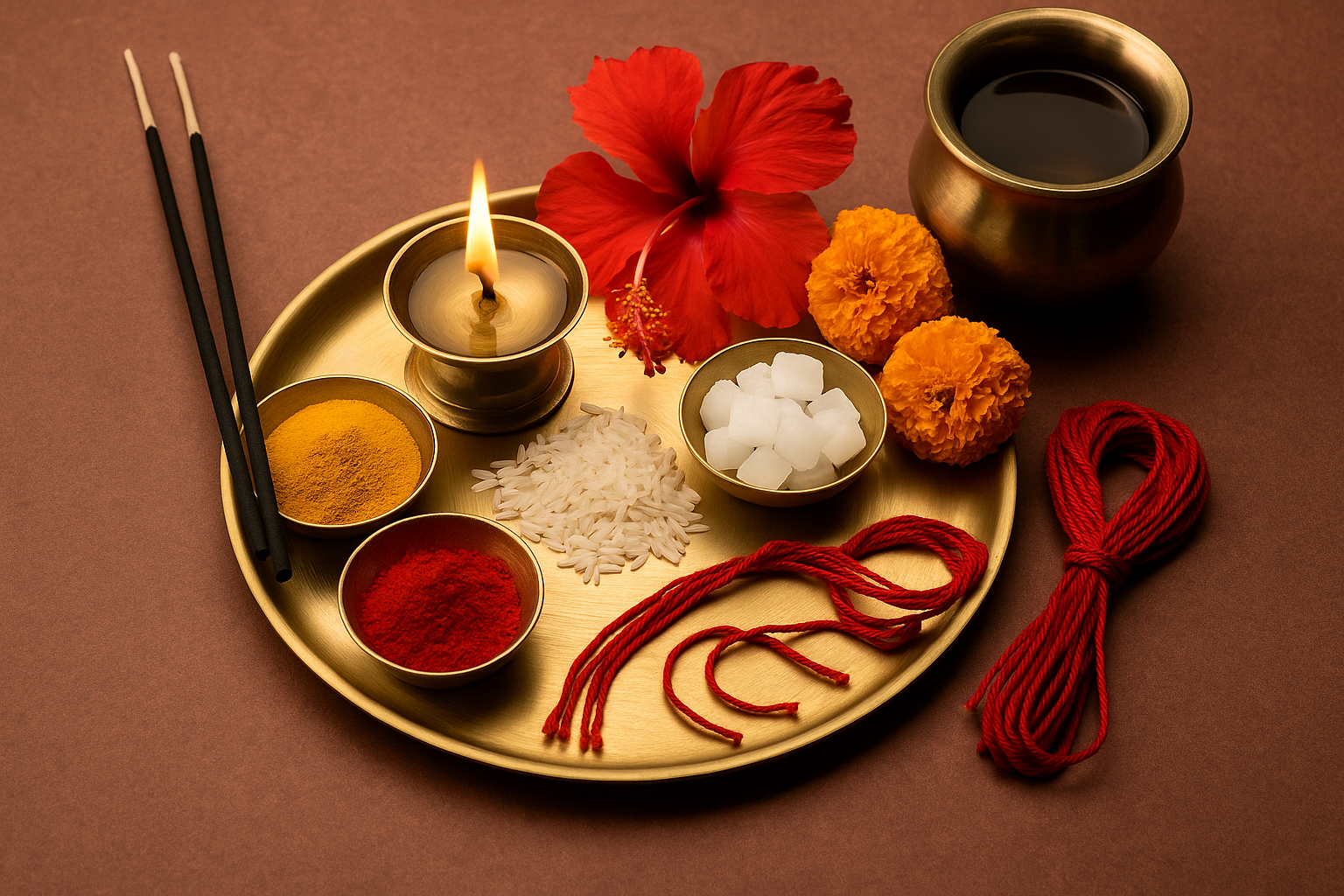Importance of Pooja Samagri in Hindu Rituals

Introduction
In the rich and vast spiritual heritage of Hinduism, rituals (pooja’s) are a potent vehicle for communicating with the divine. At the center of each ritual is Pooja Samagri—a set of sacred materials that are not only ritualistic instruments but bearers of symbolic energy and spiritual intention. Each one of them has a vital function in aligning the devotee’s mind, body, and soul with cosmic energies.
What is Pooja Samagri?
Pooja Samagri is the overall materials needed for a pooja. The materials can change based on the god being prayed to, the occasion, local cultures, or the rituals themselves. Still, there are some items that are important across most forms of Hinduism.
The following are some common Pooja Samagri items along with their symbolic interpretations:
Incense sticks (Agarbatti): Cleanse the atmosphere and represent scattering of prayers to the heavens.
Camphor (Kapoor): Burns entirely with no residue, showing complete defeat of the ego.
Flowers (Phool): Symbol of beauty, newness, and the ephemeral nature of existence.
Diyas (Oil lamps): Source of light that repels ignorance and invites divine power.
Turmeric (Haldi): Symbol of purity, wellness, and fertility.
Kumkum (Vermilion): Auspicious sign and symbolizes Shakti, the divine feminine power.
Sacred thread (Mauli or Kalava): Symbolizes protection, loyalty, and benedictions of the divine.
Grains of rice (Akshat): Representation of fertility and richness; presented whole to signify totality.
Significance of Routine Pooja Items
Now, let’s explore the deeper spiritual meaning behind pooja items and how they help in ritualistic worship:
1. Diya (Oil Lamp)
A diya is a representation of divine light that exists in life. Lighting the lamp means shunning ignorance and the journey of knowledge, wisdom, and reality.
The fire is also a symbol of the Atman (soul)—immortal and unbreakable.
2. Incense Sticks (Agarbatti)
The ascending smoke of incense means our prayers going up to heaven.
Its scent cleanses the atmosphere and prepares the devotee for a meditative, peaceful frame of mind.
3. Kumkum and Haldi (Turmeric)
These holy powders are applied for tilak on the forehead, symbolizing the third eye or Ajna Chakra, the seat of intuition.
Haldi is viewed as a medicative herb, whereas kumkum is most commonly used as a way of worshiping goddess Shakti.
4. Flowers
Placing fresh flowers is an expression of respect and worship.
Each type of flower carries its meaning—for instance, red hibiscus to Goddess Kali, whereas the lotus conveys purity as well as divinity of form.
5. Camphor (Kapoor)
Is a symbol for detachment and leaving oneself to divine will.
No residue is left behind when incensed, similar to the freeing of the soul from worldly connections.
6. Sacred Thread (Mauli/Kalava)
Worn around the wrist, it is said to ward off evil forces and remind the wearer of his or her religious promises.
7. Holy Water (Gangajal)
For purification and consecration.
Regarded very auspicious and said to cleanse body and soul.
Regional and Cultural Significance
In India, the Pooja Samagri might vary region-wise, community-wise, and deity-wise. For instance:
Banana leaves, sandalwood paste, and coconut are popular in South India.
Roli, akshat, betel leaves, and betel nuts are typical in North India.
Durga Puja sees a detailed arrangement of samagri like bel leaves, dhuno (resin), and sindoor in Bengal.
All these regional variations attest to the diversity of Hindu worship even as the core belief in purity, devotion, and energy flow remains the same.
Why Pooja Samagri Matters?
Here’s why it is important to use proper and sacred pooja materials:
Spiritual Concentration: The process of setting up and offering materials demands attention, which puts the devotee in a meditative mood.
Symbolic Strength: Every material symbolizes greater spiritual realities and divine qualities.
Divine Bond: Rituals done with pure intention and proper samagri facilitate a stronger spiritual connection with the deity.
Energetic Balance: Done with perfection, pooja builds a positive energy field around the environment, leading to harmony, peace, and prosperity.
Conclusion
Pooja Samagri is not just a list of products—it is the essence of every Hindu ritual. It has the power to raise an ordinary act of devotion to a life-altering spiritual experience. By knowing and honoring the significance of Pooja Samagri in Hindi rituals, one can worship with more faith, consciousness, and harmony with the divine.
Own the significance of every item, and your rituals will be more than tradition—they will be a journey of the soul.
Visit Bhav Your Online Premium Religious Essentials Store
📲 Follow us on Instagram for more spiritual items and offers:
👉 @bhavstore.in (Featured by @premium.dukaan)
Stay blessed, stay connected. 🙏

